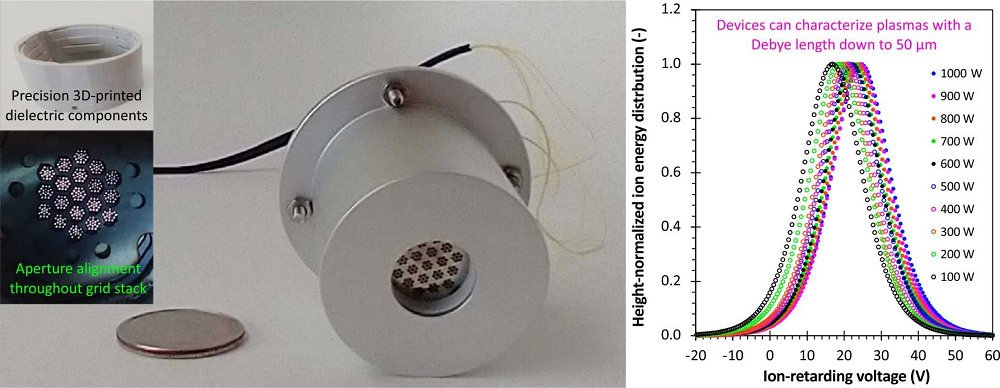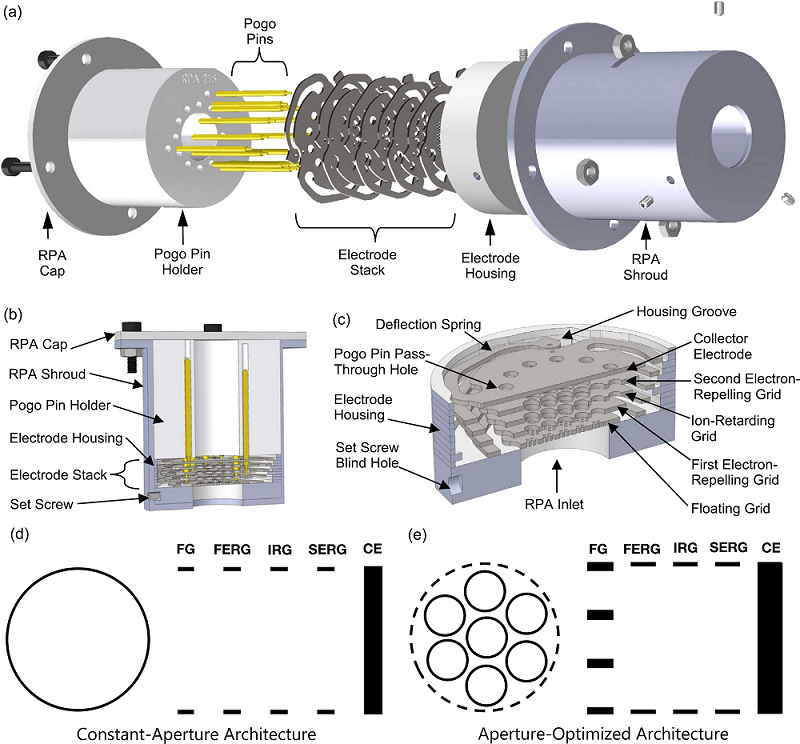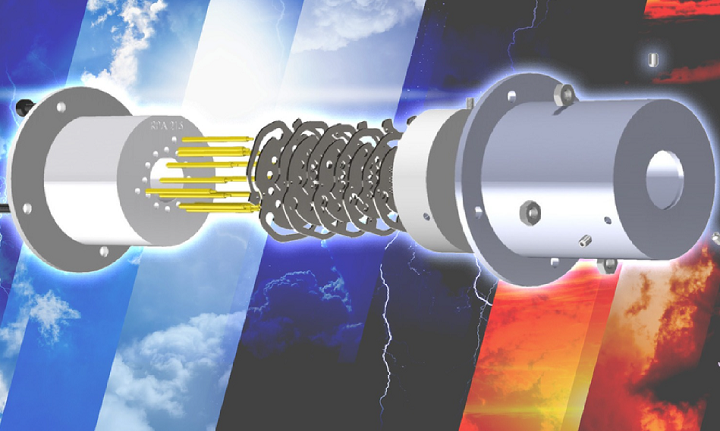A team of researchers from MIT fabricated what they say are the first fully digitally manufactured plasma sensors, known as retarding potential analyzers (RPAs), for orbiting spacecraft. Satellites use this type of sensor to investigate the ion energy distribution and chemical composition of the atmosphere, which means they can help scientists study climate change, and even predict the weather. The team published a paper on their work, “Compact retarding potential analyzers enabled by glass-ceramic vat polymerization for CubeSat and laboratory plasma diagnostics,” in Additive Manufacturing.
“We report the design, fabrication, and characterization of novel, digitally manufactured, compact retarding potential analyzers (RPAs), i.e., multi-electrode instruments that can be used as in-orbit mass spectrometers and as on-ground/in-orbit ion energy analyzers. Unlike most RPAs reported in the literature, our devices enforce active aperture alignment across the grid stack, maximizing ion transmission,” the team states in the abstract.
 Graphical abstract
Graphical abstractMy first job out of college was as an associate producer for the local CBS affiliate; I helped write and organize stories for different newscasts, then went in the booth and made sure everything ran smoothly during the live broadcast. Sometimes a story would break during the show, so I’d have to drop a less important piece to make room for the new one, or if we were running long, I would cut the lottery numbers for the night. But one thing you can’t cut is weather, especially in Ohio, where the forecast can change on a dime, and predicting it takes a lot of work. 3D printing has been used to help with weather research before, and I’m sure it will be again.
The first time an RPA was used in a space mission was back in 1959, so it’s not a new concept. These versatile sensors can detect the charged particles floating in plasma, enabling them to measure energy and conduct chemical analyses from onboard an orbiting spacecraft. As plasma passes through the tiny holes in the electrically charged meshes of the sensor, all particles are stripped away until ions are all that’s left, which then create an electric current that’s measured and analyzed by the sensor. The housing structure that aligns the RPA’s meshes is important, as it has to be electrically insulating, as well as able to hold up under drastic, sudden temperature changes.
The MIT researchers used a 3D printable glass-ceramic material called Vitrolite—used often in the colorful tiles you see in art deco buildings—to make RPA components, as the material displays the necessary properties. Not only is it more durable than more conventional sensor materials like thin-film coatings and silicon, but it can also withstand temperatures up to 800°C, unlike the polymers in semiconductor RPAs that typically start melting at 400°C.
“When you make this sensor in the cleanroom, you don’t have the same degree of freedom to define materials and structures and how they interact together,” explained Luis Fernando Velásquez-García, a principal scientist in MIT’s Microsystems Technology Laboratories (MTL) and senior author of the paper. “What made this possible is the latest developments in additive manufacturing.”
Most of the time when you’re 3D printing ceramics, a laser powder bed system is used, but according to the MIT researchers, the high heat can cause weak points and leave the material coarse. The team instead used vat polymerization, which builds a 3D structure one layer at a time by repeatedly submerging it into a vat of liquid material—Vitrolite in this case—and curing each layer with UV light. This technology can print smooth, complex, pore-free ceramic shapes, which is exactly what the researchers needed. They were able to print laser-cut meshes with unique shapes, so that the holes would perfectly line up once inside the RPA housing; this allows more ions to pass through and results in higher-resolution measurements.
In the paper, the team did note that binder jetting could be used to 3D print the metallic parts of the sensor, though they did not have access to the necessary equipment during the study to try it out. Instead, they outsourced those parts.
“The RPA designs described in this report could be fully 3D printed; in particular, the metallic parts could be made via binder material jetting—a printing technique that has been shown to produce metal parts that are ultra-high vacuum (UHV) compatible, with adequate resolution for producing finely featured, miniaturized hardware,” they wrote.
 Schematics of the digitally manufactured RPAs developed in this study: exploded view (a), cross-section of assembled RPA (b), and close-up cross-section of electrode stack and electrode housing when assembled (c). Schematics of the constant-aperture (d) and aperture-optimized architectures (e). In (d) and (e) FG = floating grid, FERG = first electron-repelling grid, SERG = second electron-repelling grid, IRG = ion-retarding grid, and CE = collector electrode.
Schematics of the digitally manufactured RPAs developed in this study: exploded view (a), cross-section of assembled RPA (b), and close-up cross-section of electrode stack and electrode housing when assembled (c). Schematics of the constant-aperture (d) and aperture-optimized architectures (e). In (d) and (e) FG = floating grid, FERG = first electron-repelling grid, SERG = second electron-repelling grid, IRG = ion-retarding grid, and CE = collector electrode.The team designed four unique designs for the sensor prototypes, because they could be fabricated so quickly and at low cost; these qualities make the sensors a good fit for low-power, lightweight CubeSats, which are used often for environmental monitoring and communication. One of the designs was great at capturing and measuring a wide range of plasma, while another was better at sensing very dense and cold plasma.
“Additive manufacturing can make a big difference in the future of space hardware,” Velásquez-García said. “Some people think that when you 3D-print something, you have to concede less performance. But we’ve shown that is not always the case. Sometimes there is nothing to trade off.”
The researchers found that their 3D printed and laser-cut hardware performed just as well as the more expensive semiconductor plasma sensors manufactured in a cleanroom over several weeks. Using 3D printing makes it possible to produce these high-precision sensors for much less time and money.
“If you want to innovate, you need to be able to fail and afford the risk,” Velásquez-García concluded. “Additive manufacturing is a very different way to make space hardware. I can make space hardware and if it fails, it doesn’t matter because I can make a new version very quickly and inexpensively, and really iterate on the design. It is an ideal sandbox for researchers.”
 Layout of the floating grid for the four RPA designs explored in this study. Each electrode has three curved deflection springs evenly distributed along its edge that are used to assemble the electrode to the housing.
Layout of the floating grid for the four RPA designs explored in this study. Each electrode has three curved deflection springs evenly distributed along its edge that are used to assemble the electrode to the housing.Velásquez-García has more in mind for these sensors in the future, such as decreasing the layer thickness or pixel size in the glass-ceramic vat polymerization process to make even more precise hardware, or using artificial intelligence to optimize the design of the sensors for specific use cases, like majorly reducing their mass while keeping them structurally sound. Additionally, he says that 3D printing the entirety of the sensors would make them compatible with in-space manufacturing.
Subscribe to Our Email Newsletter
Stay up-to-date on all the latest news from the 3D printing industry and receive information and offers from third party vendors.
You May Also Like
3D Printing News Briefs, April 13, 2024: Robotics, Orthotics, & Hypersonics
In 3D Printing News Briefs today, we’re focusing first on robotics, as Carnegie Mellon University’s new Robotics Innovation Center will house several community outreach programs, and Ugogo3D is now working...
Rail Giant Alstom Saves $15M with 3D Printing Automation Software 3D Spark
3D Spark has entered into a three-year deal with the rail giant Alstom. Alstom, a transport behemoth with annual revenues of $16 billion, specializes in the manufacture of trains, trams,...
Meltio Expands Global Reach with New Partnerships in the Americas and Europe
Spanish 3D printing manufacturer Meltio has expanded its sales network across the globe. With the addition of three new partners in the United States, Brazil, Argentina, and Italy, Meltio aims...
3D Printing Webinar and Event Roundup: April 7, 2024
Webinars and events in the 3D printing industry are picking back up this week! Sea-Air-Space is coming to Maryland, and SAE International is sponsoring a 3D Systems webinar about 3D...
































